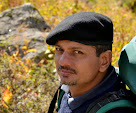Nag Tibba (Part-III)
There are three nomadic tribes in the Indian Himalayas: The Bhots, who are concentrated near passes to Indo-Tibet borders (in Sanskrit Bhot means Tibet); the Gaddis who roam Himachal highlands and; the Gurjars who are spread out from J&K and Himachal to Uttarakhand. While the first two communities rear sheep herds and trade in wool, the Gurjars tend buffalos and sell milk products. Being a Himalayan hiker, I have enjoyed the hospitality of the three communities and rate Gurjars as roughest of the lot; Gaddis are the gentlest — as different as a buffalo is from a goat.
The Gurjar abode (called channi) at Nag Devta was five minutes from where I had raised our tent (selected after finding an even ground, sweeping the stones and crafting an east-facing entry to work as an alarm clock in the morning). Nag Tibba is a another half-hour walk from Nag Devta Temple. A breathtaking view of Himalayan peaks was possible at Nag Devta spot too but a cloudy weather didn’t permit it.
Sweaty and worked-out we didn't mind the moist air. It washed off Sukriti and my fatigue (Gautam was irredeemable) and we decided to roam about the surroundings. Walking a carpet of tiny fresh flowers, we reached the Gurjar abode and were greeted by loud barks of a thick-set Tibetan mastiff. Two women came out of the hutment and after exchanging pleasantries, I took up the dinner opportunity. They agreed to cook for us but were not too happy about the camp. "Tent kahan lagaya hai? Yahan baagh aata hai, (Is this where you have pitched the tent? A tiger stalks this place)," the elderly one tried to scare us. Both Suku and I laughed it off. We were too happy to find some warm food.
Gautam forgot his fatigue when we asked him to join us for the Gurjar invite. Poor hungry soul... little did he know he would remember that dinner for the rest of his life. Inside the channi, the elderly lady told us that their menfolk were expected home in the evening but unpredictable weather in the mountains must have held them back. Possibly it was the absence of menfolk which had triggered this disinterest in the dinner. The fare — a blackish aloo-jhol & thick rotis (potato curry & coarse bread) — looked severly unappetising. I dabbed my roti into the curry to confirm my fears and cringed. There was so much dust in the curry that we had to crunch it down. Rotis were half-cooked and I gave up after the second. I have had rough & rustic dinners one too many in the hills before. But the provisions at the Gurjar channi beat them hollow. We left behind a humble appreciation in currency notes and were too happy to be back in our tents. Gautam looked the happiest, in spite of being the hungriest.
No longer did Gautam took off his shoes and entered the tent then the clouds burst into a furious crackle. Loud canons burned the skies, the temperature dipped and we hurriedly bundled into our sleeping bags. I still remember that loud snores were ringing inside our tent before I too dozed off... with little knowledge of what was in store for us.
Almost all of us woke up in a shock. Ghrrrrrr…ghurrrrrr… ghurrrrrr… there was a creature prowling around the camp, sniffing around the boundaries, moving slowly but swiftly. We went numb with fear. None of us spoke a word or dared look into each other’s eyes. The rain had stopped and a slice of moonlight outside the tent made things semi-visible. In that part-darkness, my trembling palm slipped into the rucksack and groped for the Gurkha knife I carry in every trek. I know that no knife can help against a Himalayan tiger but, since childhood, I had been told by my hill folks that a khukri under your pillow can ward off all evil. Imagine my frightened self when I realised that the knife had been left behind at Dewalsari. It looked like a pre-destined omen. For a few seconds, which felt like hours, I smelt the sweat and tension in our tent. Thankfully, the numbness paid off: the growling got distant slowly, and finally melted into the night. Life returned to the tent just as slowly. Without exchanging a word, all of us slipped inside our bags and tried to sleep off the fear. It is difficult to get forty winks after such experiences but, thankfully, it did.
It all turned out to be an anti-climax of sorts the next morning. I can still feel the embarrassment when I remember that the source of all that night growl & sniffing was neither a Himalayan bear nor the stalking tiger... but the Tibetan Mastiff dog which we had patted at the Gurjar's channi last night. I kicked my shin at the discovery, for, I should have known by experience that all shepherd dogs are let loose after the darkness falls.
(A musical retreat and mangled feet next — Nag Tibba trek comes to an end)
Subscribe to:
Post Comments (Atom)

3 comments:
Interesting descriptions - do you take photos too ?
@ amodini
Sorry to disappoint you but but I prefer to load my sack with one more rum than a heavy lens appratus. Most hill memories are etched in the head or borrowed from co-trekkers lenses (like in this post — http://pankajmolekhi.blogspot.com/2006/12/scaling-chandrashila-peak.html
the dog was a bit of an anti-climax. are their an tigers left in Uttaranchal?
havent u gone to any other state? or are u still waiting for that enfield?
Post a Comment